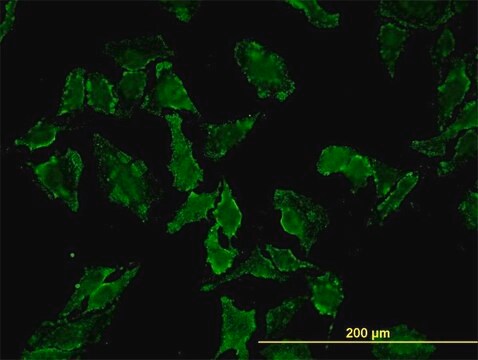MAB19562X
Anti-Laminin-5 Antibody, clone D4B5, Alexa Fluor™ 488 conjugated
clone D4B5, Chemicon®, from mouse
Sinónimos:
Anti-B2T, Anti-CSF, Anti-EBR2, Anti-EBR2A, Anti-LAMB2T, Anti-LAMNB2
About This Item
Productos recomendados
origen biológico
mouse
Nivel de calidad
conjugado
ALEXA FLUOR™ 488
forma del anticuerpo
purified immunoglobulin
tipo de anticuerpo
primary antibodies
clon
D4B5, monoclonal
reactividad de especies
human
fabricante / nombre comercial
Chemicon®
técnicas
flow cytometry: suitable
immunocytochemistry: suitable
isotipo
IgG1
Nº de acceso NCBI
Nº de acceso UniProt
Condiciones de envío
wet ice
modificación del objetivo postraduccional
unmodified
Información sobre el gen
human ... LAMC2(3918)
Categorías relacionadas
Descripción general
Especificidad
Inmunógeno
Aplicación
Flow cytometry
Optimal working dilutions must be determined by the end user.
Cell Structure
ECM Proteins
Forma física
Almacenamiento y estabilidad
Otras notas
Información legal
Cláusula de descargo de responsabilidad
Unless otherwise stated in our catalog or other company documentation accompanying the product(s), our products are intended for research use only and are not to be used for any other purpose, which includes but is not limited to, unauthorized commercial uses, in vitro diagnostic uses, ex vivo or in vivo therapeutic uses or any type of consumption or application to humans or animals.
Not finding the right product?
Try our Herramienta de selección de productos.
Código de clase de almacenamiento
12 - Non Combustible Liquids
Clase de riesgo para el agua (WGK)
WGK 2
Punto de inflamabilidad (°F)
Not applicable
Punto de inflamabilidad (°C)
Not applicable
Certificados de análisis (COA)
Busque Certificados de análisis (COA) introduciendo el número de lote del producto. Los números de lote se encuentran en la etiqueta del producto después de las palabras «Lot» o «Batch»
¿Ya tiene este producto?
Encuentre la documentación para los productos que ha comprado recientemente en la Biblioteca de documentos.
Nuestro equipo de científicos tiene experiencia en todas las áreas de investigación: Ciencias de la vida, Ciencia de los materiales, Síntesis química, Cromatografía, Analítica y muchas otras.
Póngase en contacto con el Servicio técnico







